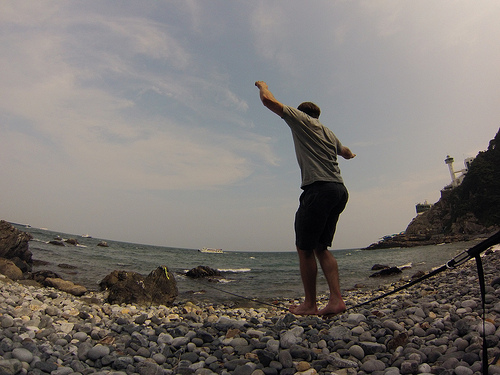Slacking off while slacklining is not the way to go.
- Slacklining is the sport of moving from one end of a slightly loose textile band situated above the ground, to the other, usually by walking, and it requires significant balancing skills, typically with arm movements to help keep balance.
- The band or webbing used for slacklining is typically long, thin and narrow, usually with a width of 2.5 to 3.5 centimetres (1 to 1.4 inches), though sometimes it is wider.
- The material used to make slackline webbing, or ‘belts’ as they are also called, is generally polyester, nylon, polypropylene or polyamide.
- While slacklining has its history in tightrope walking, which it is very much alike, the modern sport evokes an entirely new set of skills and balance techniques.
- In slacklining, the less tension in the slackline, the more difficult it is to keep balance on, due to sway and greater sagging under the weight of a person.
Slacklining
Image courtesy of Stanton Cady/Flickr
- Modern slacklining was invented in 1979 by Adam Grosowsky and Jeff Ellington, in the Yosemite Valley of the United States.
- Trees are commonly used to tie a slackline between, especially for casual slacklining, and the webbing sits off the ground, while the height from the ground can vary, as long as it does not touch it when a person’s weight is applied.
- There are four main types of slacklining variations: waterlining – over water, highlining – over a significant height off the ground, longlining – over a long distance, and tricklining – doing tricks on the slackline, though other variations also exist.
- As of 2016, the longest slackline walk was 1020 metres (3346 feet), the record set on 19 April 2016 in Aiglun, France by Nathan Paulin from France, and Danny Menšík from the Czech Republic.
- Slacklining has grown to be a relatively popular sport, especially in Europe, and it has garnered enough interest now, that professional competitions are held annually.
Bibliography:
Bryant A, Above the Lawn, Walking the Line, 2006, The New York Times, http://www.nytimes.com/2006/09/08/travel/escapes/08slack.html?_r=2&pagewanted=all&
First Steps, 2014, Landcruising, http://www.landcruising-slacklines.com/en/knowledge/first-steps
The History of Slacklining, 2014, Landcruising, http://www.landcruising-slacklines.com/en/knowledge/history
Know How – History, 2015, Slackline Tools, http://www.slackline-tools.com/know-how/history/
Slacklining, 2016, Wikipedia, https://en.wikipedia.org/wiki/Slacklining







